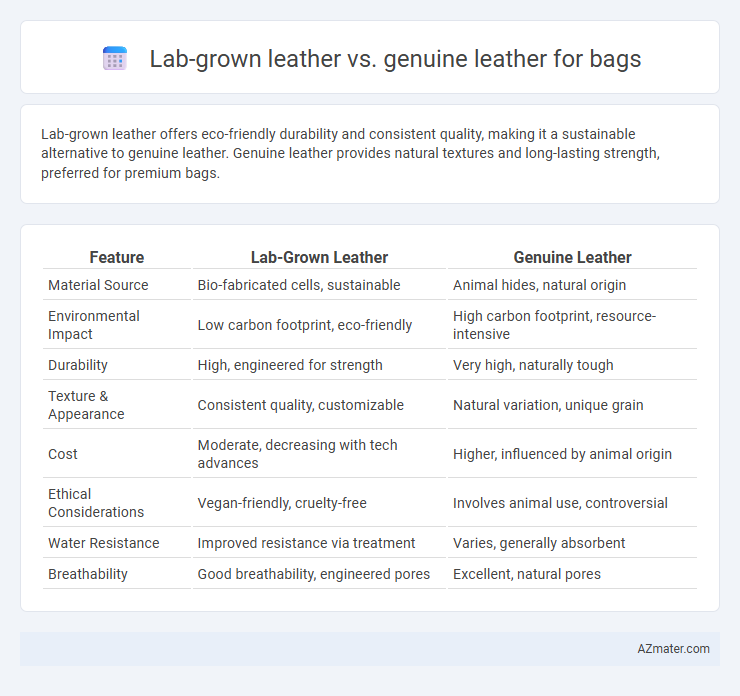Lab-grown leather offers eco-friendly durability and consistent quality, making it a sustainable alternative to genuine leather. Genuine leather provides natural textures and long-lasting strength, preferred for premium bags.
Table of Comparison
| Feature | Lab-Grown Leather | Genuine Leather |
|---|---|---|
| Material Source | Bio-fabricated cells, sustainable | Animal hides, natural origin |
| Environmental Impact | Low carbon footprint, eco-friendly | High carbon footprint, resource-intensive |
| Durability | High, engineered for strength | Very high, naturally tough |
| Texture & Appearance | Consistent quality, customizable | Natural variation, unique grain |
| Cost | Moderate, decreasing with tech advances | Higher, influenced by animal origin |
| Ethical Considerations | Vegan-friendly, cruelty-free | Involves animal use, controversial |
| Water Resistance | Improved resistance via treatment | Varies, generally absorbent |
| Breathability | Good breathability, engineered pores | Excellent, natural pores |
Introduction to Lab-Grown vs Genuine Leather
Lab-grown leather, created through bio-fabrication processes using collagen or other natural fibers, offers an innovative, sustainable alternative to genuine leather derived from animal hides. Genuine leather, prized for its durability and unique texture developed over time, involves traditional tanneries that can have significant environmental impacts. Lab-grown leather reduces dependence on livestock farming, minimizes water usage, and lowers carbon emissions while maintaining comparable strength and aesthetic qualities sought in luxury bags.
What is Lab-Grown Leather?
Lab-grown leather, also known as cultured or bio-fabricated leather, is produced by growing animal cells in a controlled environment to create a sustainable and cruelty-free alternative to genuine leather. This innovative material mimics the texture, strength, and appearance of traditional leather without the environmental impact associated with livestock farming and tanning processes. Brands using lab-grown leather for bags emphasize reduced carbon footprint, water conservation, and elimination of toxic chemicals, appealing to eco-conscious consumers seeking high-quality, ethical fashion.
The Process of Making Genuine Leather
The process of making genuine leather for bags involves tanning animal hides to preserve and enhance durability, typically through chrome or vegetable tanning methods. This traditional approach requires skilled labor to treat and finish the leather, resulting in a material known for its unique texture, strength, and aging characteristics. Genuine leather's production process is resource-intensive, relying on livestock farming and chemical treatments that contribute to environmental impact concerns.
Environmental Impact Comparison
Lab-grown leather significantly reduces environmental impact by utilizing fewer natural resources and generating less carbon dioxide compared to genuine leather, which involves livestock farming responsible for high methane emissions and deforestation. The production of lab-grown leather minimizes water usage and eliminates toxic chemicals commonly used in traditional tanning processes, further decreasing pollution and soil contamination. While genuine leather offers durability, lab-grown alternatives present a sustainable solution with the potential to revolutionize the leather industry by lowering overall ecological footprints for bag manufacturing.
Durability and Longevity
Lab-grown leather offers consistent durability due to its controlled manufacturing process, often surpassing genuine leather in resistance to wear, scratches, and environmental factors. Genuine leather, while naturally flexible and breathable, develops a unique patina over time but can be prone to cracking or fading without proper care. For bag longevity, lab-grown leather provides a more uniform lifespan with less maintenance, whereas genuine leather's durability depends heavily on the quality of the hide and ongoing conditioning.
Aesthetics and Texture Differences
Lab-grown leather offers a smoother and more uniform texture compared to genuine leather, which features natural grain patterns and imperfections unique to each hide. Genuine leather develops a rich patina over time, enhancing its aesthetic appeal, while lab-grown leather maintains a consistent look without aging characteristics. Both materials can be tailored for bag design, but genuine leather's distinct texture provides a classic, authentic appearance that lab-grown alternatives currently emulate with a more synthetic finish.
Price and Market Availability
Lab-grown leather typically offers a lower price point compared to genuine leather due to reduced resource-intensive processes and scalable production methods. Market availability of lab-grown leather is rapidly increasing, with more brands adopting it to meet sustainable consumer demands, while genuine leather remains widely available but often commands a premium price due to traditional craftsmanship and material costs. This shift is driving competitive pricing and expanding options for eco-conscious bag buyers.
Ethical Considerations
Lab-grown leather for bags offers a sustainable alternative that reduces animal cruelty and environmental impact compared to genuine leather, which involves livestock farming and tanning processes harmful to ecosystems. Ethical considerations emphasize animal welfare, as lab-grown leather eliminates the need to slaughter animals, appealing to vegan consumers and those concerned with factory farming conditions. Lab-grown leather production also minimizes water usage and toxic chemical discharge, making it a more ethical choice for environmentally conscious buyers.
Consumer Preferences and Trends
Consumer preferences increasingly favor lab-grown leather for bags due to its sustainable production and ethical appeal, attracting environmentally conscious buyers. Genuine leather remains valued for its durability, natural texture, and luxury status, maintaining a strong market presence among traditional consumers. Trends indicate a growing shift towards innovative, eco-friendly materials, with lab-grown leather gaining traction in fashion industries seeking to reduce carbon footprints.
Which Leather is Best for Bags?
Lab-grown leather offers a sustainable and cruelty-free alternative to genuine leather, with enhanced durability and resistance to water and stains, making it ideal for eco-conscious bag buyers. Genuine leather provides unmatched natural texture, breathability, and a unique aging process that develops character over time, preferred by traditional luxury bag enthusiasts. The best leather for bags depends on the user's priority between environmental impact and authentic material quality.

Infographic: Lab-grown leather vs Genuine leather for Bag
 azmater.com
azmater.com